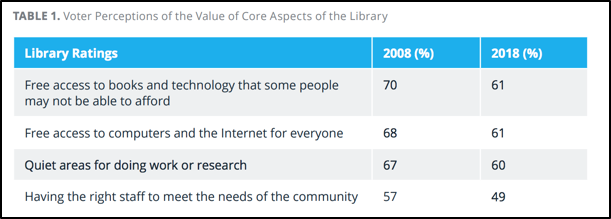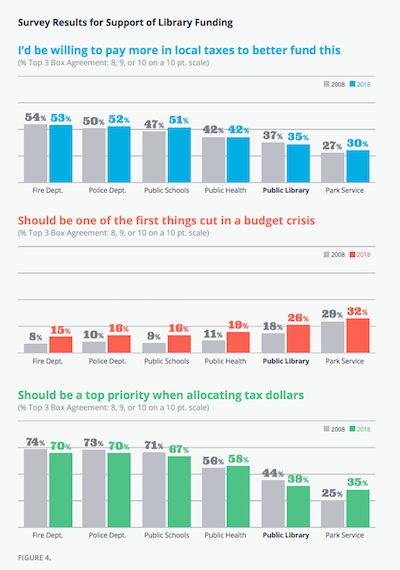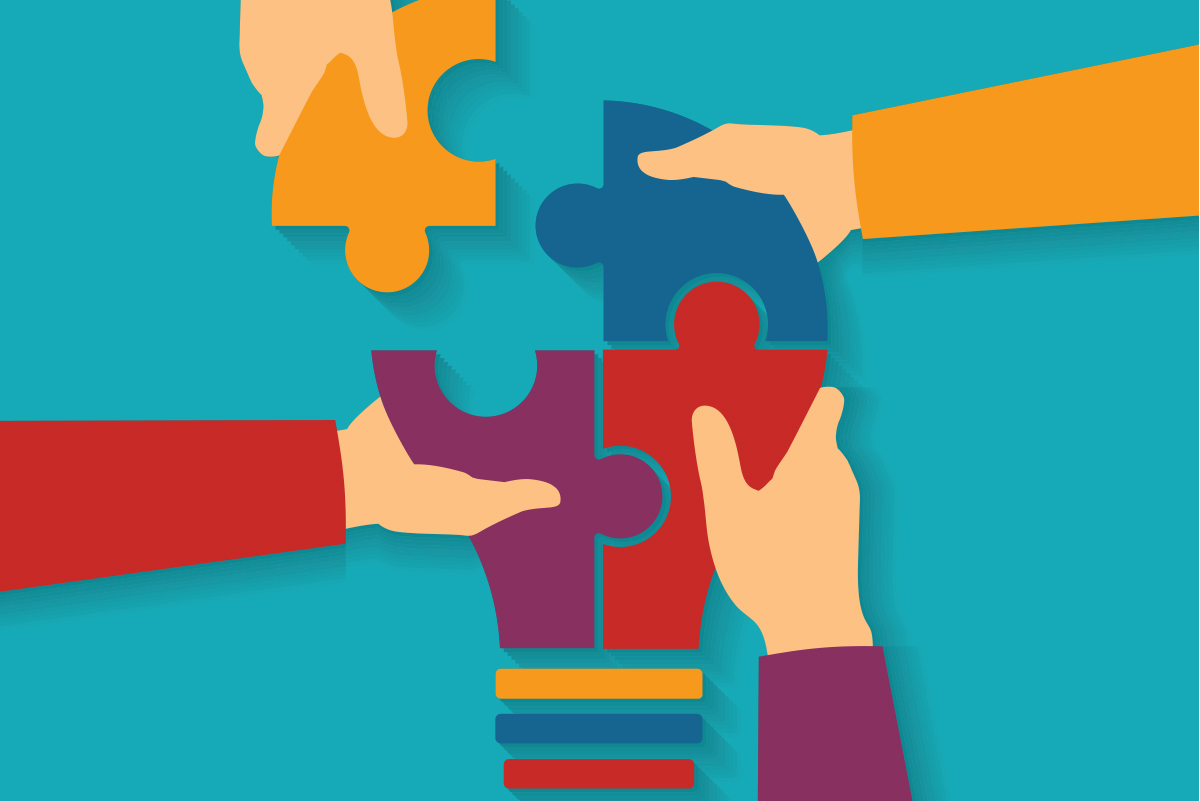
3 Actions Public Libraries Should Be Taking in Response to OCLC’s 2018 Funding Report
Ten years ago, OCLC conducted its first round of research into who supports public library funding and for what reasons. This year, the nonprofit returned to the questions it posed to 19- to 60-year-old voters, expanded its survey audience to include people aged 70 or older and those who live in large cities, and added in a few new queries about library community impact, all with the goal of seeing what’s changed and what’s remained constant over the last decade.
“From Awareness to Funding: Voter Perceptions and Support of Public Libraries in 2018” includes key findings and comparisons to insights gained in 2008. Here’s the good news:
- 55% of voters viewed the public library as an essential local institution.
- 53% viewed the library as a source of community pride.
- About half of voters saw the library as an invaluable community resource.
On the other hand, the percentage of voters who would definitely vote in favor of a referendum, ballot or bond measure in support of their local library was barely over 50% and has declined 15 percentage points in 10 years. What is driving the decline in funding support? The report highlights some of the answers, leading us to recommend three important actions libraries can take to garner voter support.
1. Shift Your Messaging to Focus on Your Community’s Needs
The report sheds light on a shift in the role of the library and the services people value, which may be contributing to the disconnect between people who voice support for the library and people who act on their support by voting for library funding. Over the past 10 years, the following common services have seen declines:
- Adult Usage: nonfiction books (-14%), fiction and bestseller books (-9%)
- DVDs: (-6%)
- Print Reference Materials: (-17%)
- Computer Searching: (-7%)
- Photocopying: (-9%)
- English as a Second Language Classes: (-15%)
In addition to a shift in usage of common services, voters’ perceptions of the core aspects of their libraries are changing as well (see Table 1). It’s clear that if libraries are going to continue to foster public support and activate supporters at the ballot box, a messaging overhaul is in order.

Before developing new messaging, libraries need to better understand their communities’ expectations. To start this process, many libraries are “turning outward.” This phrase, coined by the Harwood Institute of Public Innovation, describes a process that libraries are undertaking “that entails taking steps to better understand their communities; changing processes and thinking to make conversations more community-focused; being proactive to community issues and putting community aspirations first.”
Community focus is paramount when it comes to engaging the populations that libraries serve, so the American Library Association (ALA) has developed extensive online resources that will help libraries strengthen their roles as community leaders. ALA’s “A Step-By-Step Guide to ‘Turning Outward’ to Your Community” breaks this community-centered process into four steps:
- Getting started: For the first 30 days, libraries should focus on determining their own hopes and goals and start to implement processes that will lead to long-term change.
- Going into the community: During the next 30–60 days, libraries should begin leading conversations with the communities they serve.
- Sharing what you learn: The 60–90 mark is the perfect time to share knowledge and evaluate progress towards library goals.
- Taking action: Once they’ve reached 90 days and beyond, libraries should focus on making this new orientation standard moving forward. This is also the right time to transform library programming and services to meet community needs, whether that means launching a makerspace or reenvisioning physical areas as community gathering spots.
2. Enlighten Your Community About Library Funding
Not only do the majority of voters support federal funding for libraries, saying that the federal government should increase or keep the same levels of funding, but the majority of voters have also either contributed to fundraising efforts or are willing to contribute to future ones.
Yet, only 35% of voters would be willing to pay more in local taxes to better fund the public library.

Confusion around sources of public library funding is a major contributor to the decline in support for local referenda. Even though the Institute of Museum and Library Services (IMLS) reports that 85% of public library funding comes from local sources, a full 59% of voters think most library funding comes from non-local sources. Statistics like these led OCLC to declare that “bolstering local support for library funding is one of the most pressing needs faced by public libraries today.”
How can libraries address this? They can start by taking advantage of every available opportunity to enlighten patrons. WebJunction suggests preparing staff to counter common myths likely to be brought up in funding conversations. To help, they’ve published a list of “reality checks” that are informative responses to commonly encountered myths, including the following:
- “My library has plenty of money — it just used grant funding to open a new computer lab.” To respond to this statement, libraries should offer more insight intohowrestrictive grants can be. Patrons may not know that local, state and federal grants can only be used for the specific purpose identified in the grant.
- “A new library means that the library has loads of money in its budget.” Explaining how capital budget differs from operating budget will help debunk this myth.
- “Every public library in the United States is funded in the same way.” Since each library has a unique mix of funding sources, this is a great opportunity for libraries to educate patrons on their unique funding situations.

OCLC and American Library Association. 2018. From Awareness to Funding: Voter Perceptions and Support of Public Libraries in 2018.
3. Prepare for the Next Decade … and Beyond
It’s hard to predict what pressing needs OCLC will find if it conducts this same survey in 2028. However, libraries can be proactive about preparing for the next decade by prioritizing involvement in their communities and continuing to evolve to meet the needs of their users. Action plans should include the following:
- Maximizing the time library staff spends outside of physical branches serving and acquiring new patrons.
- Making time to listen deeply to their communities’ needs and respond to those needs with new partnerships and services.
- Transforming services to meet users’ evolving needs by providing makerspaces, community rooms, space for entrepreneurs, early literacy services and more.
- Vocalizing and explaining the library’s reliance on local funding to harness voter support.
Looking for more insight into how you can navigate an uncertain library landscape? Join our mailing list today for industry insights delivered straight to your inbox!
Sources
Common Public Library Funding Myths
From Awareness to Funding: Voter Perceptions and Support of Public Libraries in 2018
Turning Outward Resources for Libraries
![]()
Find New Ways to Engage
Join our mailing list to get inspiring and informative content delivered straight to your inbox.
Related Resources
You Responded, We Listened: Wandoo Reader Survey Results and Plans for 2019
Discover what we learned from our Wandoo Reader customer survey and how we are using the results to enhance current features and develop new functionality for 2019.
read moreExplore the Benefits of Offering Online and In-Person Learning at Your Library
Are you interested in offering online learning opportunities while still continuing to hold in-person programs at your library? Explore the benefits of both learning formats and get ideas on ways they can complement each other.
read more4 Signs that Your Community Is Ready for a Library Mobile App
Are you thinking about investing in a library mobile app, but you’re not sure if your patrons would use it? Use this checklist to help you determine if your community is truly ready for a library mobile app.
read more





